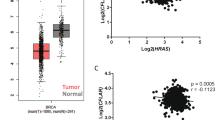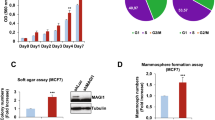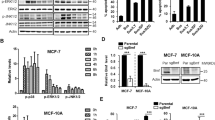Abstract
Detachment of epithelial cells from the basement membrane (BM) induces apoptosis, a phenomenon now widely known as anoikis. Studies in mammary and intestinal epithelial cells have shown that the loss of attachment to the BM rapidly triggers reversible proapoptotic events from which the cells can recover if they reattach within a certain period. Thus, cells seem to be transiently protected from the initial detachment-induced proapoptotic events. The molecular mechanisms underlying such transient protection against anoikis are unknown. In this paper, we present evidence indicating that detachment of intestinal epithelial cells triggers a transient, yet significant increase in the activity of the tyrosine kinases c-Src and c-Fyn, and that this activation of Src-family kinases (SFK) contributes to the transient protection against anoikis in these cells. The protective signals from SFK are mediated by the PI3K pathway, and caveolin-1. In addition, we show that the MEK1-ERK1/2 pathway acts in a synergistic manner with SFK to protect intestinal epithelial cells from anoikis.
This is a preview of subscription content, access via your institution
Access options
Subscribe to this journal
Receive 50 print issues and online access
$259.00 per year
only $5.18 per issue
Buy this article
- Purchase on Springer Link
- Instant access to full article PDF
Prices may be subject to local taxes which are calculated during checkout









Similar content being viewed by others
References
Aoudjit F and Vuori K . (2001). J. Cell Biol., 152, 633–643.
Bain J, McLauchlan H, Elliot M and Cohen P . (2003). Biochem. J., 371, 199–204.
Biscardi JS, Tice DA and Parsons SJ . (1999). Adv. Cancer Res., 76, 61–119.
Carver LA, Schnitzer JE, Anderson RGW and Mohr S . (2003). Cancer Res., 63, 6571–6574.
Coucouvanis E and Martin GR . (1995). Cell, 83, 279–287.
Evan GI and Vousden KH . (2001). Nature, 411, 342–348.
Fiucci G, Ravid D, Reich R and Liscovitch M . (2002). Oncogene, 21, 2365–2375.
Frame MC . (2002). Biochim. Biophys. Acta, 1602, 114–130.
Frisch SM . (1999). Curr. Biol., 9, 1047–1049.
Frisch SM and Francis H . (1994). J. Cell Biol., 124, 619–626.
Frisch SM and Ruoslahti E . (1997). Curr. Opin. Cell Biol., 9, 701–706.
Frisch SM and Screaton RA . (2001). Curr. Opin. Cell Biol., 13, 555–562.
Fukazawa H, Noguchi K, Murakami Y and Uehara Y . (2002). Mol. Cancer Ther., 1, 303–309.
Gilmore AP, Metcalfe AD, Romer LH and Streuli CH . (2000). J. Cell Biol., 149, 431–445.
Grossmann J . (2002). Apoptosis, 7, 247–260.
Grossmann J, Artinger M, Grasso A, Kung HJ, Scholmerich J, Fiocchi C and Levine AD . (2001a). Gastroenterology, 120, 79–88.
Grossmann J, Walther K, Artinger M, Kiessling S and Scholmerich J . (2001b). Cell Growth Differ., 12, 147–155.
Ikeda H, Suzuki Y, Suzuki M, Koike M, Tamura J, Tong J, Nomura M and Itoh G . (1998). Gut, 42, 530–537.
Inoue O, Suzuki-Inoue K, Dean WL, Frampton J and Watson SP . (2003). J. Cell Biol., 160, 769–780.
Ishida K, Nagahara H, Kosigo T, Aso T, Hayashi N and Akaike T . (2002). Biochem. Biophys. Res. Commun., 300, 201–208.
Jamal HH, Cano-Gauci DF, Buick RN and Filmus J . (1994). Oncogene, 9, 417–423.
Krestow JK, Rak J, Filmus J and Kerbel RS . (1999). Biochem. Biophys. Res. Commun., 260, 48–53.
Lee H, Volonte D, Galbiati F, Iyengar P, Lublin DM, Bregman DB, Wilson MT, Campos-Gonzalez R, Bouzahzah B, Pestell RG, Scherer PE and Lisanti MP . (2000). Mol. Endocrinol., 14, 1750–1775.
Li S, Seitz R and Lisanti MP . (1996). J. Biol. Chem., 271, 3863–3868.
Lin EH, Hui AY, Meens JA, Tremblay EA, Schaefer E and Elliot BE . (2004). Exp. Cell Res., 293, 1–13.
Loza Coll M, Rosen K, Ladeda V and Filmus J . (2002). Oncogene, 21, 2908–2913.
Maher PA . (2000). Exp. Cell Res., 260, 189–198.
Meredith JE, Fazeli B and Schwartz MA . (1993). Mol. Biol. Cell, 4, 953–961.
Meredith JE and Schwartz MA . (1997). Trends Cell Biol., 7, 146–150.
Obergfell A, Eto K, Mocsai A, Buensuceso C, Moores SL, Brugge JS, Lowell CA and Shattil SJ . (2002). J. Cell Biol., 157, 265–275.
Okamoto T, Schlegel A, Scherer PE and Lisanti MP . (1998). J. Biol. Chem., 273, 5419–5422.
Ottenhoff-Kalff AE, Rijksen G, van Beurden EA, Hennipman A, Michels AA and Staal GE . (1992). Cancer Res., 52, 4773–4778.
Quaroni A and May RJ . (1980). Methods in Cell Biology, Vol. 218. Academic Press, Inc.: New York, pp. 403–427.
Rak J, Mitsuhashi Y, Erdos V, Huang S-N, Filmus J and Kerbel RS . (1995). J. Cell Biol., 131, 1587–1598.
Reed BH, Wilk R, Schock F and Lipshitz HD . (2004). Curr. Biol., 14, 372–380.
Reginato MJ, Mills KR, Paulus JK, Lynch DK, Sgroi DC, Debnath J, Muthuswamy SK and Brugge JS . (2003). Nat. Cell Biol., 5, 733–740.
Rosen K, Loza Coll M, Li A and Filmus J . (2001). J. Biol. Chem., 276, 37273–37279.
Rosen K, Rak J, Leung T, Dean NM, Kerbel RS and Filmus J . (2000). J. Cell Biol., 149, 447–455.
Rosen K, Shi W, Calabretta B and Filmus J . (2002). J. Biol. Chem., 277, 46123–46130.
Rytomaa M, Lehman K and Downward J . (2000). Oncogene, 19, 4461–4468.
Rytomaa M, Martins LM and Downward J . (1999). Curr. Biol., 9, 1043–1046.
Schlaepfer DD, Hanks SK, Hunter T and van der Geer P . (1994). Nature, 372, 786–791.
Sevignani C, Wlodarski P, Kirillova J, Mercer WE, Danielson KG, Iozzo RV and Calabretta B . (1998). J. Clin. Invest., 101, 1572–1580.
Strange R, Li F, Saurer S, Burkhardt A and Friis RR . (1992). Development, 115, 49–58.
Wang P, Valentijn AJ, Gilmore AP and Streuli CH . (2003). J. Biol. Chem., 278, 19917–19925.
Weng Z, Xin M, Pablo L, Gruneberg D, Hagel M, Bain G, Muller T and Papkoff J . (2002). J. Biol. Chem., 277, 18677–18686.
Windham TC, Parikh NU, Siwak DR, Summy JM, McConkey DJ, Kraker AJ and Gallick GE . (2002). Oncogene, 21, 7797–7807.
Young MA, Gonfloni S, Superti-Furga G, Roux B and Kuriyan J . (2001). Cell, 105, 115–126.
Zheng XM, Resnick RJ and Shalloway D . (2002). J. Biol. Chem., 277, 21922–21929.
Zheng XM and Shalloway D . (2001). EMBO J., 20, 6037–6049.
Acknowledgements
We thank Heather Bird for her assistance in the preparation of this manuscript, and Gisele Knowles for her advice and technical support with the flow cytometry measurements.
Author information
Authors and Affiliations
Corresponding author
Rights and permissions
About this article
Cite this article
Loza-Coll, M., Perera, S., Shi, W. et al. A transient increase in the activity of Src-family kinases induced by cell detachment delays anoikis of intestinal epithelial cells. Oncogene 24, 1727–1737 (2005). https://doi.org/10.1038/sj.onc.1208379
Received:
Revised:
Accepted:
Published:
Issue Date:
DOI: https://doi.org/10.1038/sj.onc.1208379
Keywords
This article is cited by
-
The NF2 tumor suppressor merlin interacts with Ras and RasGAP, which may modulate Ras signaling
Oncogene (2019)
-
Cadmium-Induced Ototoxicity in Rat Cochlear Organotypic Cultures
Neurotoxicity Research (2014)
-
A phase 1 study of gemcitabine combined with dasatinib in patients with advanced solid tumors
Investigational New Drugs (2013)
-
Redox regulation of anoikis resistance of metastatic prostate cancer cells: key role for Src and EGFR-mediated pro-survival signals
Oncogene (2009)
-
Redox regulation of anoikis: reactive oxygen species as essential mediators of cell survival
Cell Death & Differentiation (2008)



